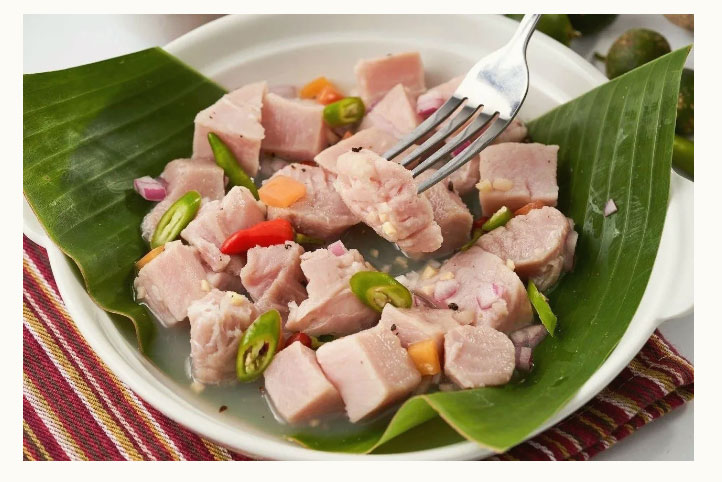
Kinilaw, sometimes pronounced as kilawin is a surprisingly complicated dish compared to the other Filipino dishes available. A few of my friends (Parey) expressed their opinion to me as “cooking cat meat is easier than cooking this fish dish called Kinilaw”. While reading about the dish and later on while tasting the food, it seems quite similar to the Peruvian delicacy ‘Ceviche’. But when I wanted to cook the dish, I understood that it is different. To understand the difference between Ceviche and Kinilaw, you have to visit and re-visit the origin of the dish and the attached folklores too. Hence, let us jump and try to dig out some details about it.
To understand the details about ceviche, I would request you to visit https://thechroniclekhana.com/old-blogs but for Kinilaw it is here. Fruit juice or lemon juice is considered one of the major elements for ceviche but kinilaw, is vinegar or nothing. Short marination is also another key for kinilaw. Apart, coconut vinegar, calamansi juice, garlic, onions, ginger, and chillies are some other ingredients which are used. There is evidence available to understand that kinilaw is at least 1000 years older than the Spanish ceviche. “Tabon-tabon is a fruit which is plenty in Northern Mindanao of the Philippines. In 1987, Butuan Balangay dig out evidence of tabon-tabon halves and fish bones together which proves the acidic medium for this dish is tabon-tabon fruit”.
Vocabulario de la Lenguna Pampanga en Romance (1732) has written evidence which mentions a dish which is meat cooked slightly through marination only known as ‘Quilao’ and almost from the same duration Vocabulario de la Lengua Tagala (1754) states that a dish called ‘Quilauin’ where meat or fish is marinated only in vinegar or in nothing. The Visayans, Mindanaoans, Tagalogs, Ilocanos or Pangasinense – no one can claim that their region has created the dish. No documentary evidence about the regional origin is available, but there is ample logic available to debate.
The major difference between a Peruvian Ceviche and a Philipino Kinilaw is that the marination time for Ceviche is at least six hours but whereas, the Kinilaw is fresh with 100% raw texture of fish. The cooking happens inside the stomach of humans with the presence of body acids.
There are various meanings available for the term kinilaw or Quilao: In Bulacan, it means ‘to eat or to make. Cebuano-Visayan refers to ‘to eat meat, fish, tubers etc. raw/with only salt and vinegar. In Samar-Leyte it means preparing or seasoning. According to Vocabulario de la Lengua Bicol it means ‘to eat raw food’. Hilao means to eat meat or fish raw according to Hiligaynon/Haraya.
Researching the history and origin of the dish I have gone into depth and found some interesting details which are a must-read:
According to Primo Viaggio Intorno al Mondo (Report on the First Voyage around the World), the experience gathered by Portuguese Explorer Magellan was unexpected. Instead of involving in a fight, the island people started offering them gifts. Offering gifts to a foreigner was a tradition by the people of that Island which later was named the Philippines. The major gifts offered to them were fresh fish and palm wine. It could be easily understood through this gesture that they offered wine to their guest and as an accompaniment, they had offered fresh fish which in today’s concept is known as Kinilaw. Few poetic lines express Kinilaw better and which are available in a dictionary named ‘Vocabulario de la Lengua’ by Juan de Noceda and Pedro de Sanlucar:
“Cun ang quilai,i, masair (masaid)
At ang toytoy ay matiti (matiktik)
Tapus ang pagcacaibig”…….
Translates to “When the kilawin is consumed, And the wine bottle is emptied, The friendship (love) is ended”.
The evidence available in Diccionario Geografico, Estadistico, and Historico le las Filipinas about this primitive dish wherein has been guided that how to keep fresh fish fresh just before eating. Kinilaw is not always about fish. Vocabulario de la lengua Tagala (1613) by Pedro de San Buenaventura mention “Cqilavin mo yaring anvang” – translates to “Make kinilaw of this carabao (meat)”. In another book by Diego Bergaño entitled Vocabulario de la Lengua Pampanga en romance (1732), as “eating meat slightly cooked but [still] raw,” and also mentioned young deer and other young animals.
Folklore is also tracked with the dish. It is a funny myth which goes into everyone’s mouth in the Philippines.
“There was once a Kingdom ruled by a king and he had an excellent Chef named Eslaw. One day the King asked his chef that, whether, he can prepare something out of the box. The chef started thinking very hard and went to the kitchen where he saw a basket full of fresh fish. He took the basket of fish, clean and cut the meat of the fish into cubes and kept it in a bowl. He then added the fermented coconut juice, salt and marinate so that the raw smell goes off. Added some ginger and green chilly to give it a jerk and finally squeezed some tabon tabon extract to make it savoury. During lunch, he had been served the latest discovery of Chef Eslaw. After taking a bite the King was so surprised and happy that he stated “Kini Law! Kini akong gipangita na kalami sa pagkaon! Kini Law! Maayo…maayo!”. (translation: “You got it (Kini), Law! (short for Eslaw) This is exactly the kind of yumminess that I’ve been looking for. You got it (Kini), Law! Good Job…Good job!”). In between this happening, a lady servant went inside the pantry to fetch some wine for the King and another elderly lady servant enquired about the name of the dish for which the King was so happy. The young lady servant replied ‘Kinilaw’ as the King was yelling this name. Probably from this root the name Kinilaw came into the picture”.



